Презентация communicative language teaching

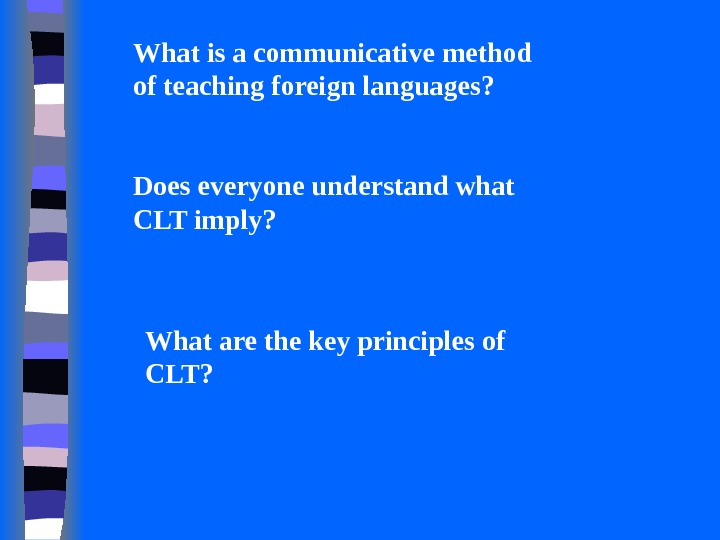
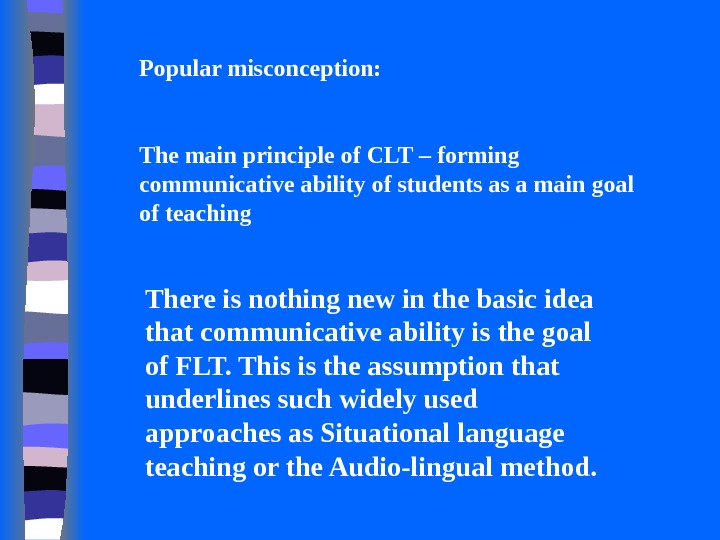
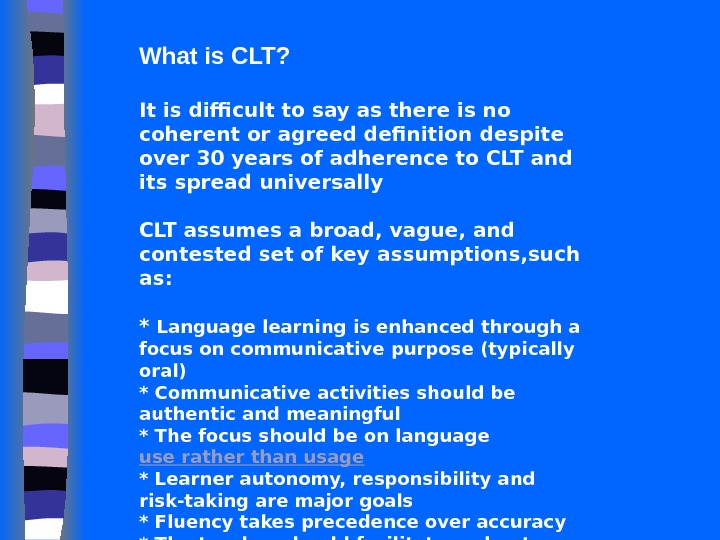
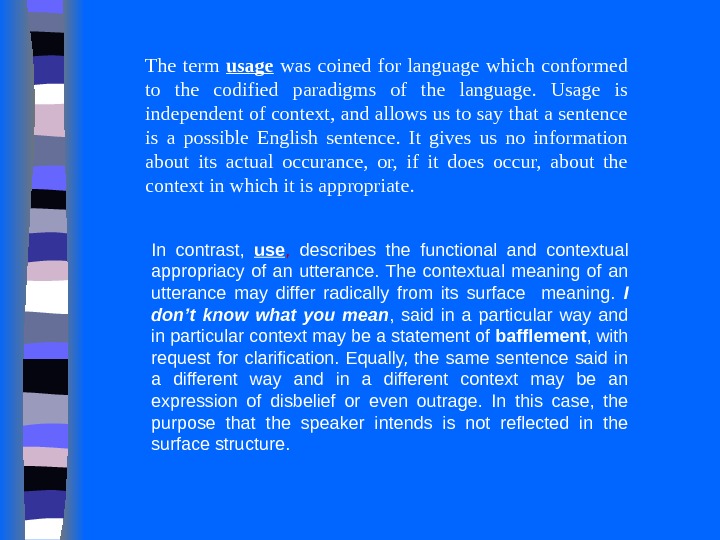
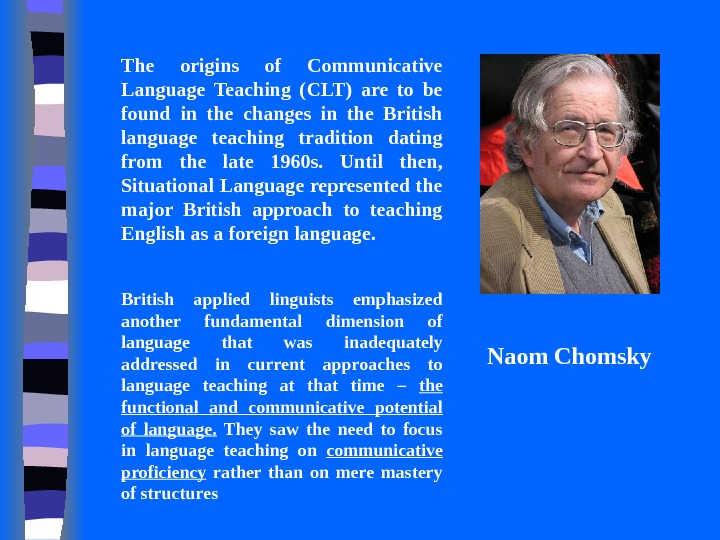
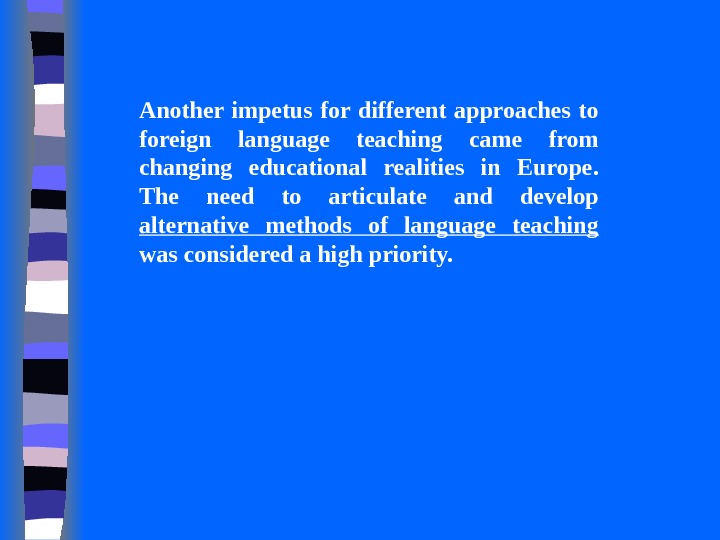


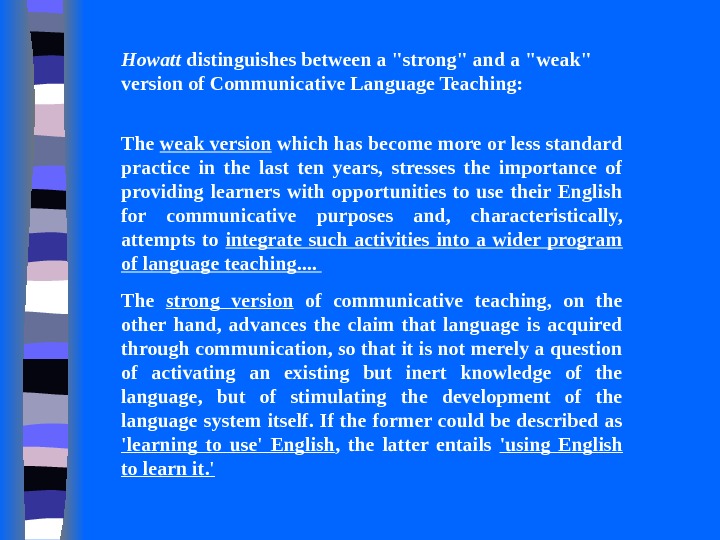
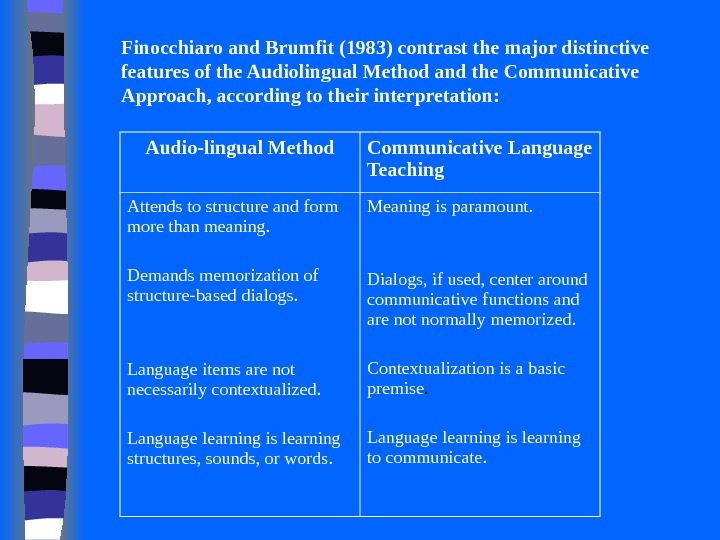
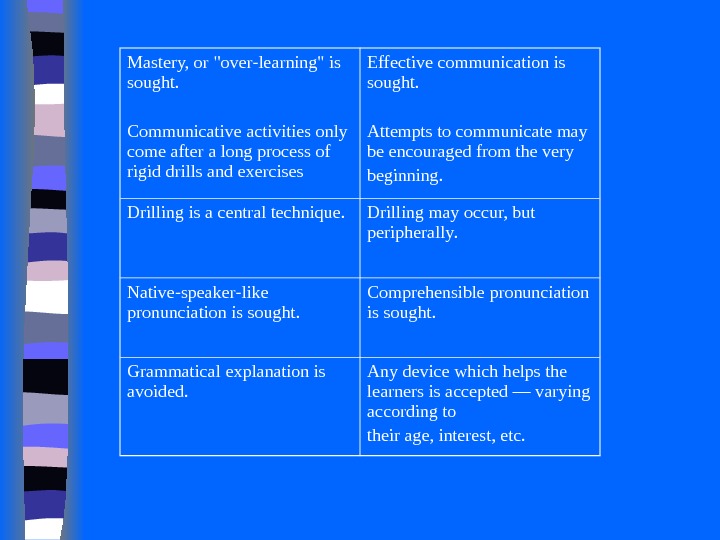
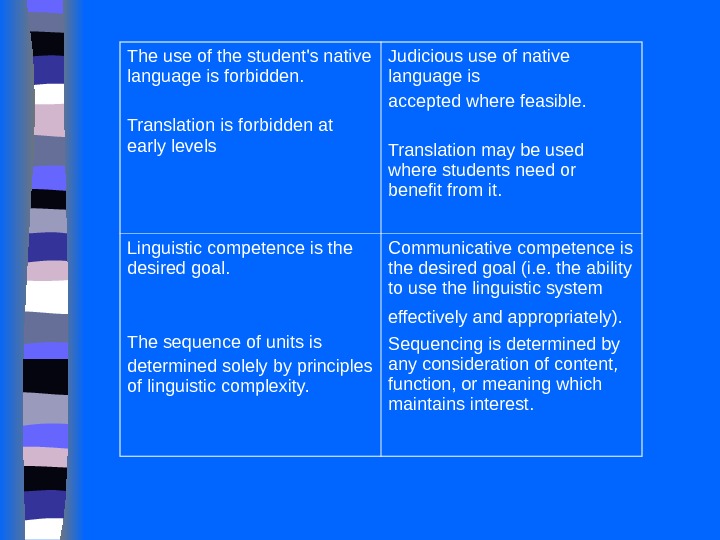
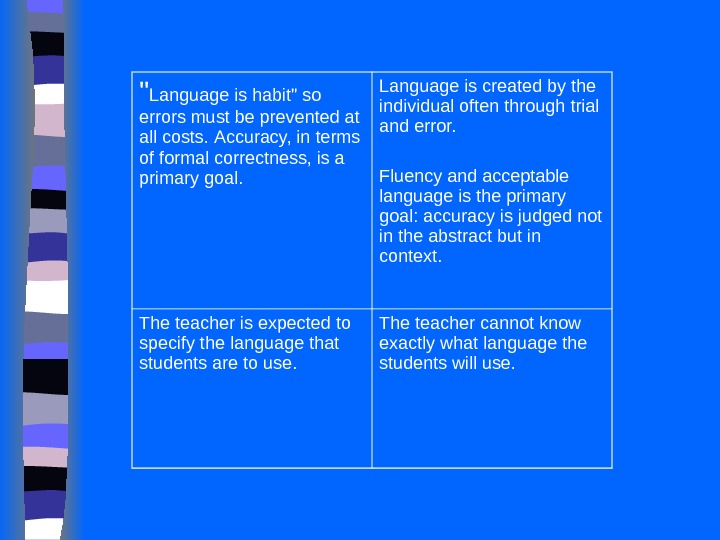
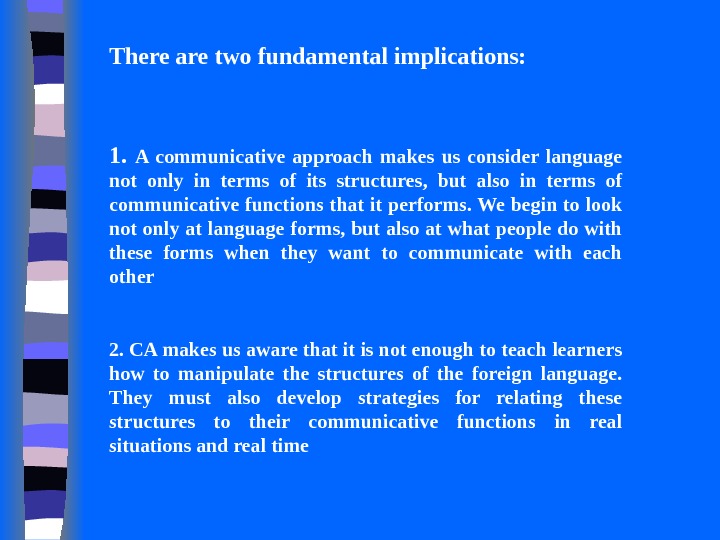
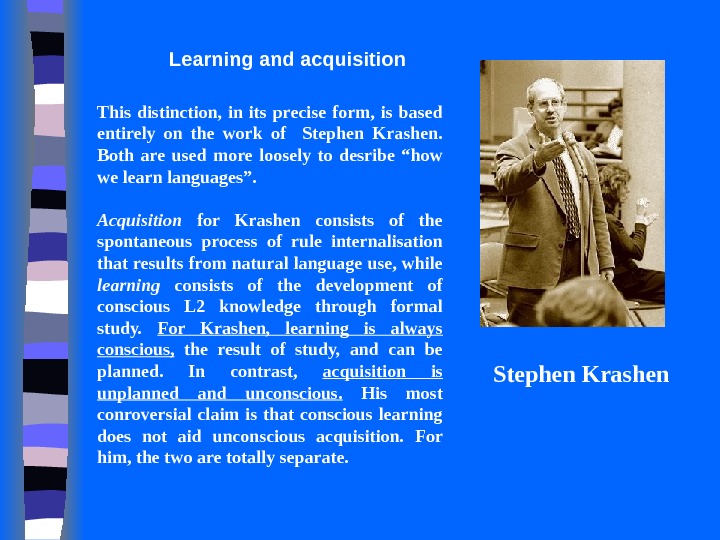
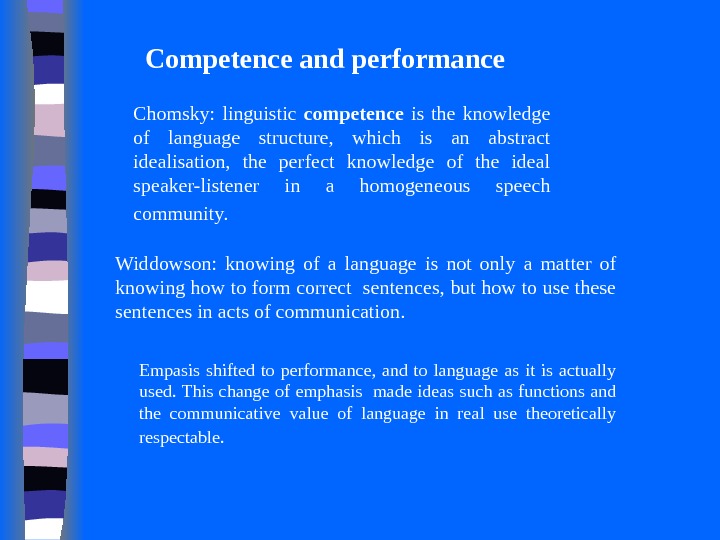
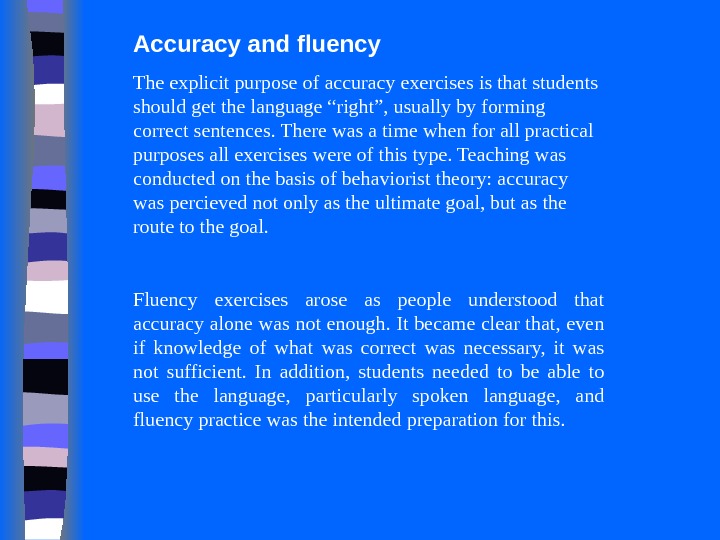
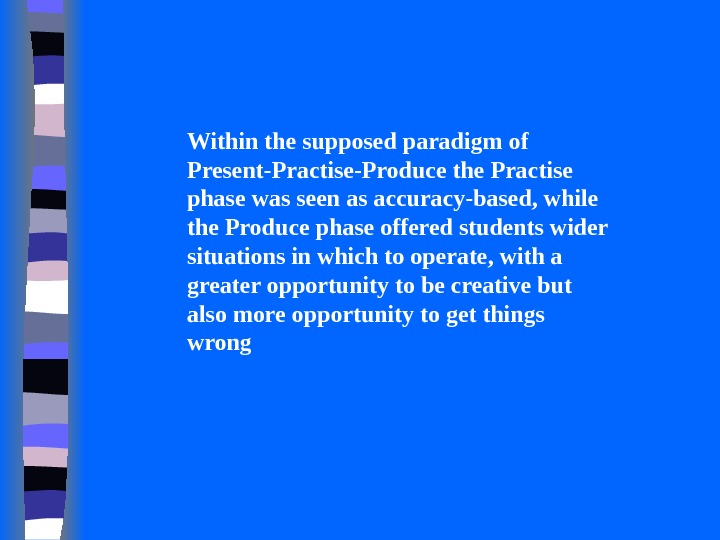
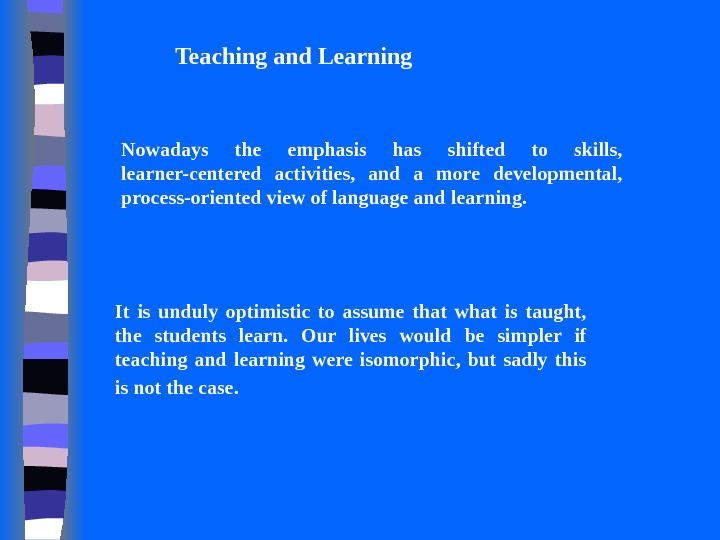
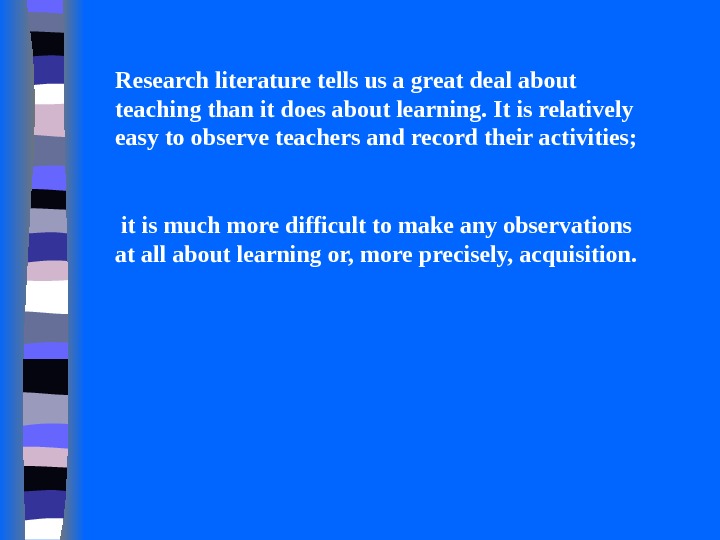
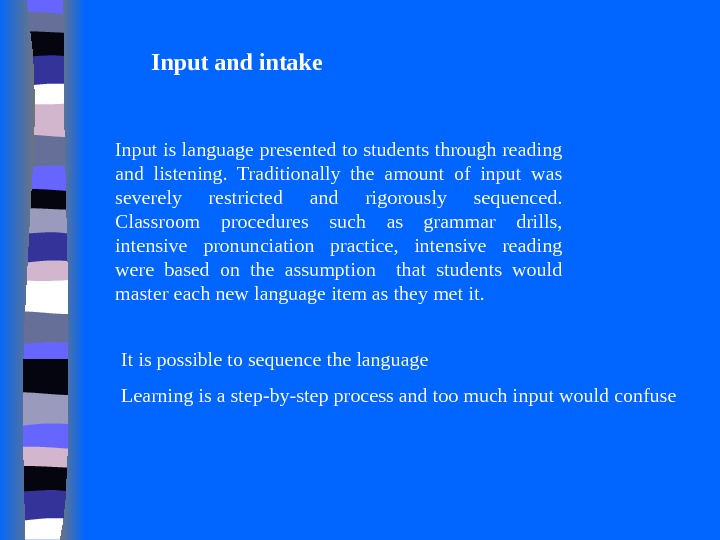
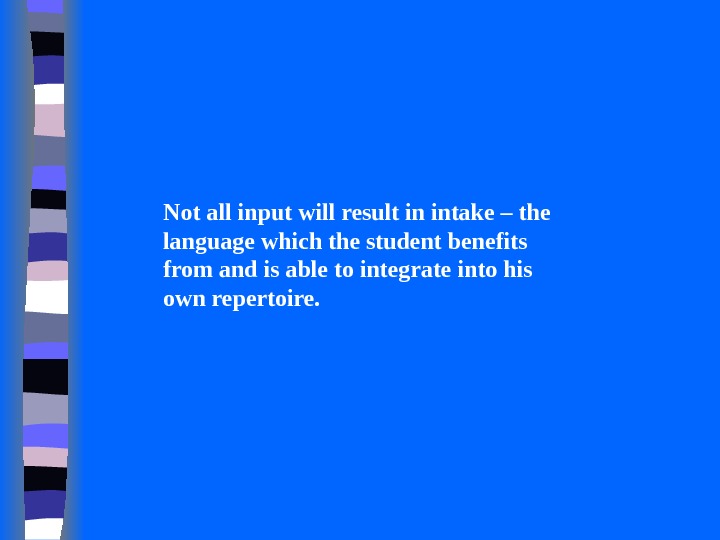
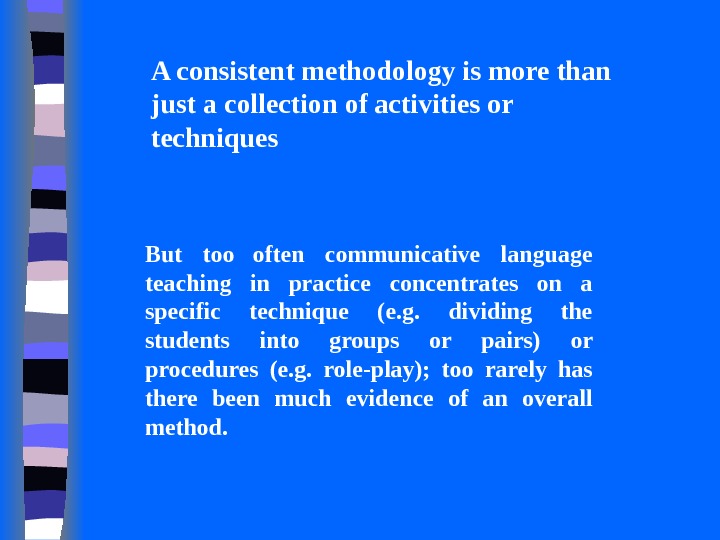
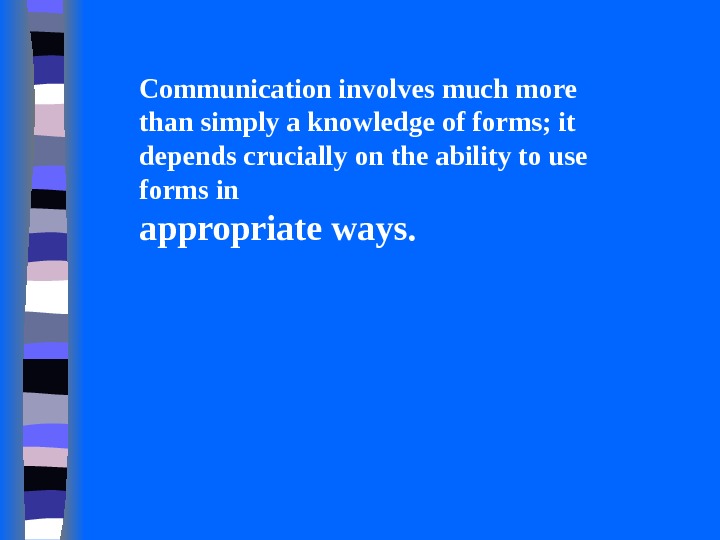
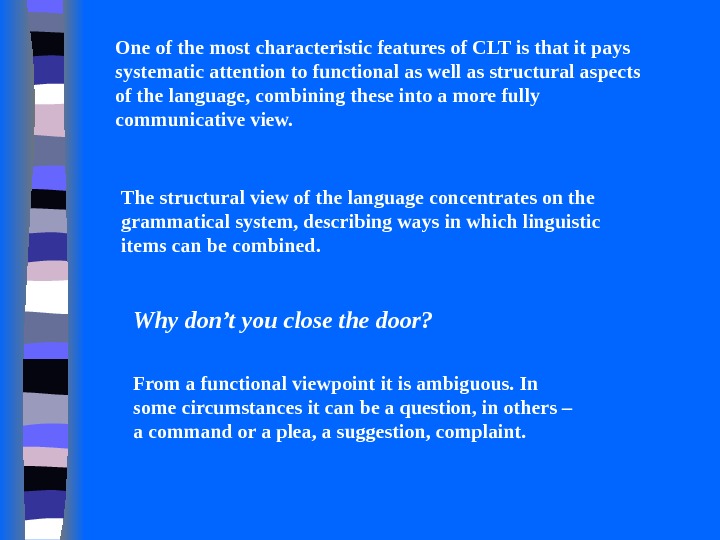


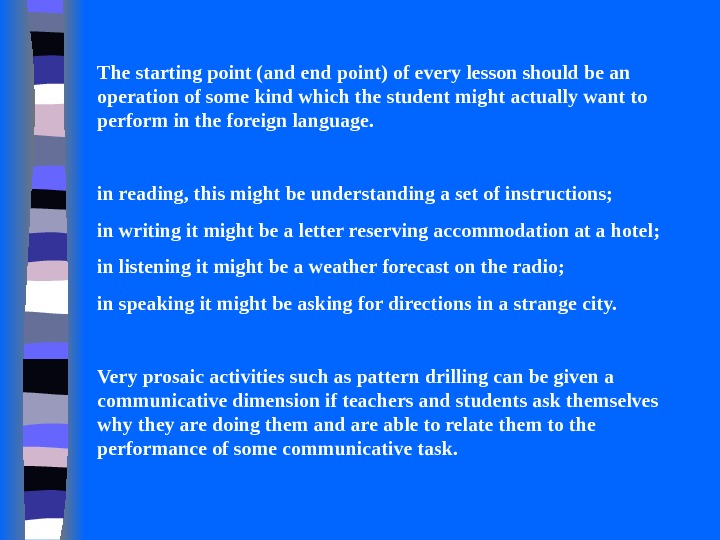
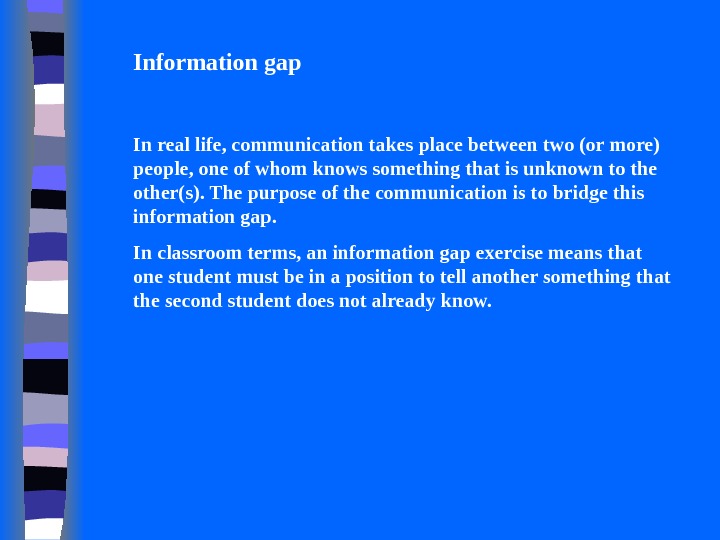

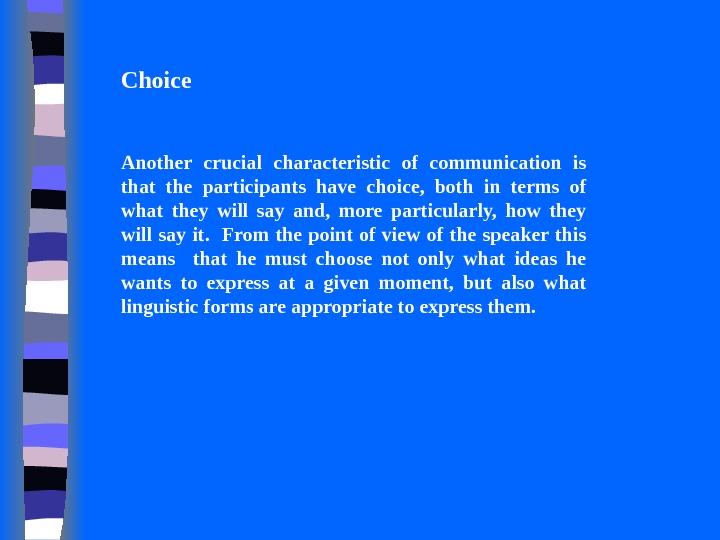

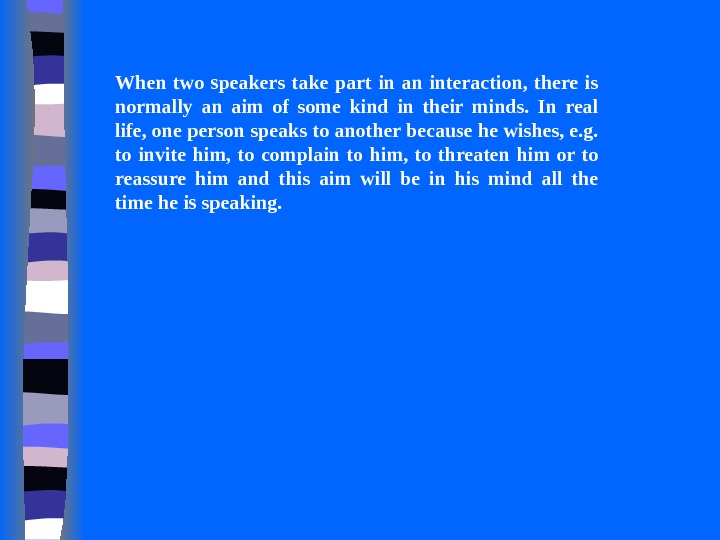
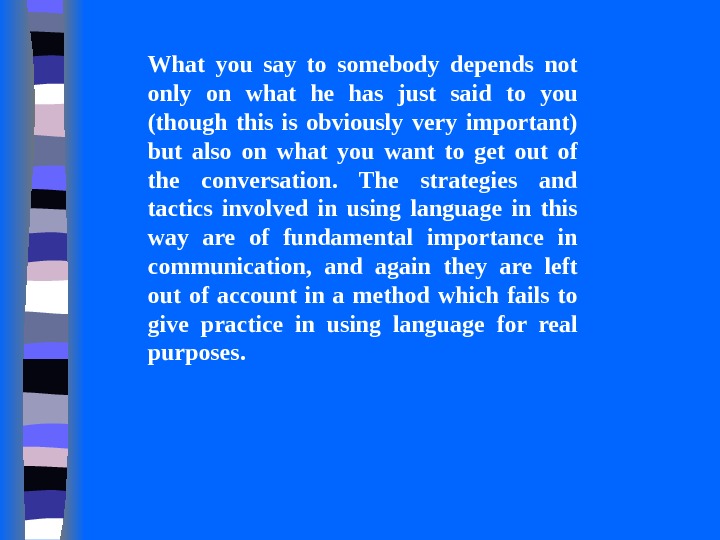
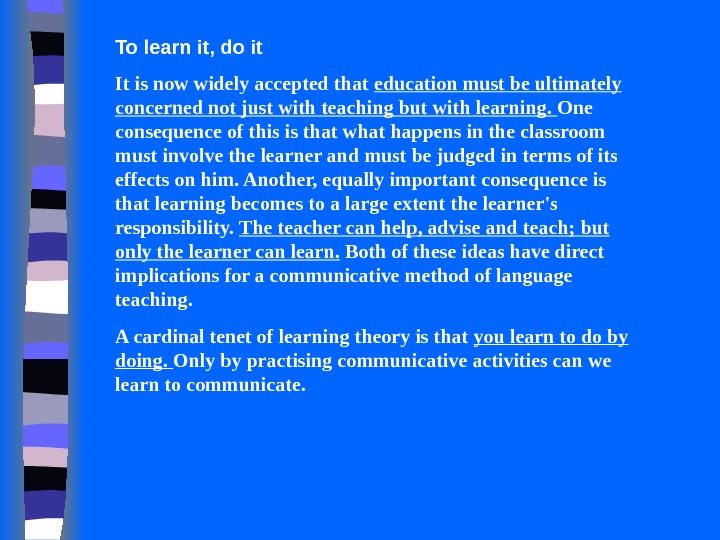
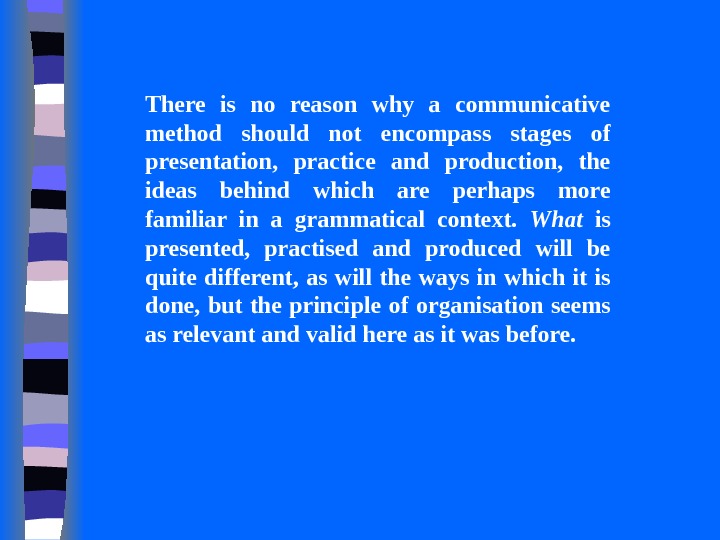
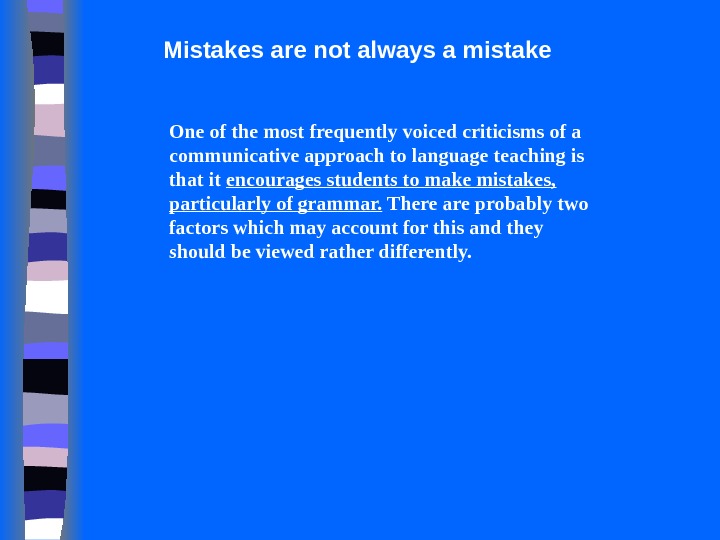
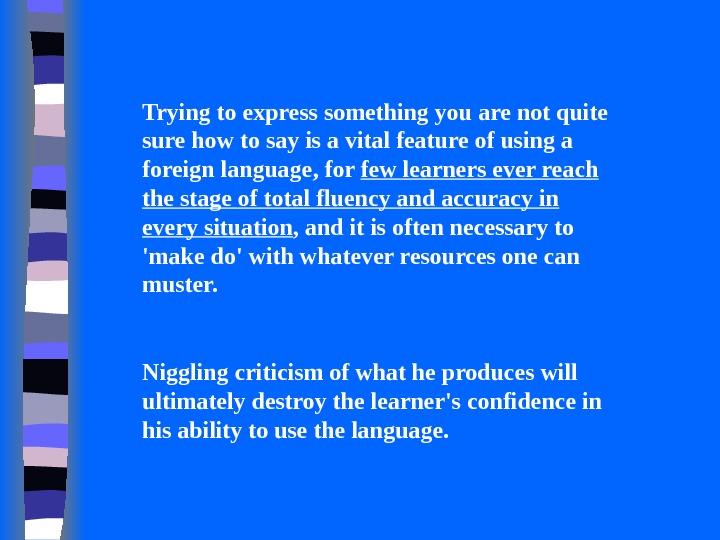


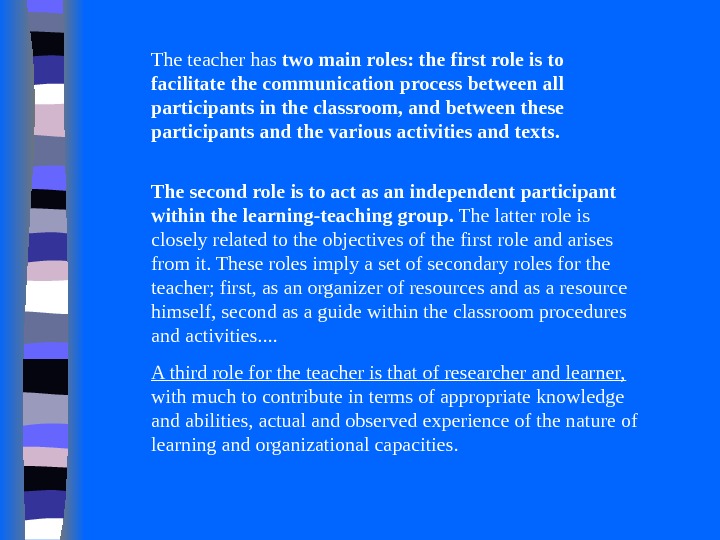


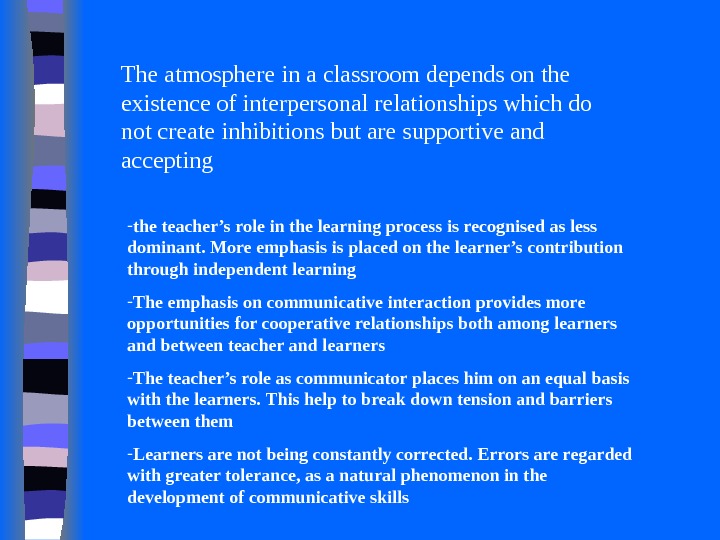
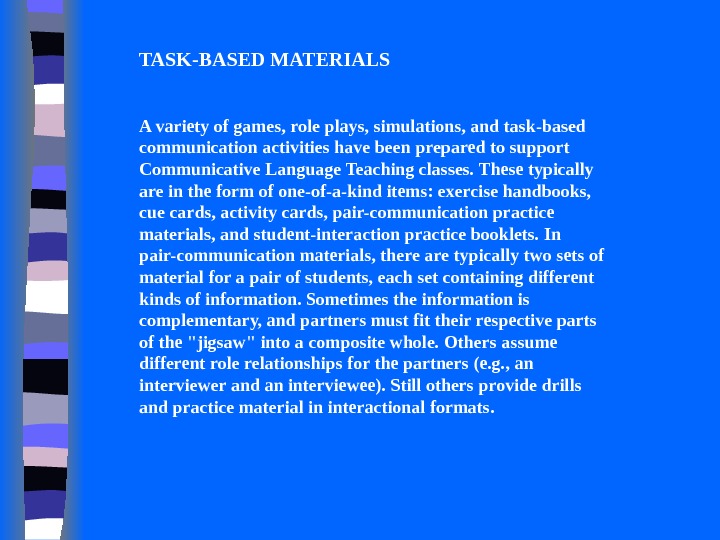
- Размер: 877 Кб
- Количество слайдов: 45
Описание презентации Презентация communicative language teaching по слайдам
 What is a communicative method of teaching foreign languages? Does everyone understand what CLT imply? What are the key principles of CLT?
What is a communicative method of teaching foreign languages? Does everyone understand what CLT imply? What are the key principles of CLT?
 There is nothing new in the basic idea that communicative ability is the goal of FLT. This is the assumption that underlines such widely used approaches as Situational language teaching or the Audio-lingual method. Popular misconception: The main principle of CLT – forming communicative ability of students as a main goal of teaching
There is nothing new in the basic idea that communicative ability is the goal of FLT. This is the assumption that underlines such widely used approaches as Situational language teaching or the Audio-lingual method. Popular misconception: The main principle of CLT – forming communicative ability of students as a main goal of teaching
 What is CLT? It is d ifficult to say as there is no coherent or agreed definition despite over 30 years of adherence to CLT and its spread universally CLT a ssumes a broad, vague, and contested set of key assumptions, such as: * L anguage learning is enhanced through a focus on communicative p urpose (ty p ically oral) * C ommunicative activities should be authentic and meaningful * T he focus should be on language use rather than usage * L earner autonomy, responsibility and risk-taking are major goals * F luency takes precedence over accuracy * T he teacher should facilitate and not control learning
What is CLT? It is d ifficult to say as there is no coherent or agreed definition despite over 30 years of adherence to CLT and its spread universally CLT a ssumes a broad, vague, and contested set of key assumptions, such as: * L anguage learning is enhanced through a focus on communicative p urpose (ty p ically oral) * C ommunicative activities should be authentic and meaningful * T he focus should be on language use rather than usage * L earner autonomy, responsibility and risk-taking are major goals * F luency takes precedence over accuracy * T he teacher should facilitate and not control learning
 The term usage was coined for language which conformed to the codified paradigms of the language. Usage is independent of context, and allows us to say that a sentence is a possible English sentence. It gives us no information about its actual occurance, or, if it does occur, about the context in which it is appropriate. In contrast, use , describes the functional and contextual appropriacy of an utterance. The contextual meaning of an utterance may differ radically from its surface meaning. I don’t know what you mean , said in a particular way and in particular context may be a statement of bafflement , with request for clarification. Equally, the same sentence said in a different way and in a different context may be an expression of disbelief or even outrage. In this case, the purpose that the speaker intends is not reflected in the surface structure.
The term usage was coined for language which conformed to the codified paradigms of the language. Usage is independent of context, and allows us to say that a sentence is a possible English sentence. It gives us no information about its actual occurance, or, if it does occur, about the context in which it is appropriate. In contrast, use , describes the functional and contextual appropriacy of an utterance. The contextual meaning of an utterance may differ radically from its surface meaning. I don’t know what you mean , said in a particular way and in particular context may be a statement of bafflement , with request for clarification. Equally, the same sentence said in a different way and in a different context may be an expression of disbelief or even outrage. In this case, the purpose that the speaker intends is not reflected in the surface structure.
 The origins of Communicative Language Teaching (CLT) are to be found in the changes in the British language teaching tradition dating from the late 1960 s. Until then, Situational Language represented the major British approach to teaching English as a foreign language. British applied linguists emphasized another fundamental dimension of language that was inadequately addressed in current approaches to language teaching at that time – the functional and communicative potential of language. They saw the need to focus in language teaching on communicative proficiency rather than on mere mastery of structures Naom Chomsky
The origins of Communicative Language Teaching (CLT) are to be found in the changes in the British language teaching tradition dating from the late 1960 s. Until then, Situational Language represented the major British approach to teaching English as a foreign language. British applied linguists emphasized another fundamental dimension of language that was inadequately addressed in current approaches to language teaching at that time – the functional and communicative potential of language. They saw the need to focus in language teaching on communicative proficiency rather than on mere mastery of structures Naom Chomsky
 Another impetus for different approaches to foreign language teaching came from changing educational realities in Europe. The need to articulate and develop alternative methods of language teaching was considered a high priority.
Another impetus for different approaches to foreign language teaching came from changing educational realities in Europe. The need to articulate and develop alternative methods of language teaching was considered a high priority.
 A British linguist, D. A. Wilkins (1972) proposed a functional or communicative definition of language that could serve as a basis for developing communicative syllabuses for language teaching. Wilkins’s contribution was an analysis of the communicative meanings that a language learner needs to understand express. Rather than describe the core of language through traditional concepts of grammar and vocabulary, Wilkins attempted to demonstrate the systems of meanings that lay behind the communicative uses of language.
A British linguist, D. A. Wilkins (1972) proposed a functional or communicative definition of language that could serve as a basis for developing communicative syllabuses for language teaching. Wilkins’s contribution was an analysis of the communicative meanings that a language learner needs to understand express. Rather than describe the core of language through traditional concepts of grammar and vocabulary, Wilkins attempted to demonstrate the systems of meanings that lay behind the communicative uses of language.
 The work of the Council of Europe; the writings of Wilkins, Widdowson, Candlin, Christopher Brumfit, Keith Johnson, and other British applied linguists on theoretical basis for a communicative or functional approach to language teaching; the rapid application of these ideas by textbook writers; and the equally rapid acceptance of these new principles by British language teaching specialists, curriculum development centers, and even governments gave prominence nationally and internationally to the Communicative Approach, or simply Communicative Language Teaching.
The work of the Council of Europe; the writings of Wilkins, Widdowson, Candlin, Christopher Brumfit, Keith Johnson, and other British applied linguists on theoretical basis for a communicative or functional approach to language teaching; the rapid application of these ideas by textbook writers; and the equally rapid acceptance of these new principles by British language teaching specialists, curriculum development centers, and even governments gave prominence nationally and internationally to the Communicative Approach, or simply Communicative Language Teaching.
 Howatt distinguishes between a «strong» and a «weak» version of Communicative Language Teaching: The weak version which has become more or less standard practice in the last ten years, stresses the importance of providing learners with opportunities to use their English for communicative purposes and, characteristically, attempts to integrate such activities into a wider program of language teaching. . The strong version of communicative teaching, on the other hand, advances the claim that language is acquired through communication, so that it is not merely a question of activating an existing but inert knowledge of the language, but of stimulating the development of the language system itself. If the former could be described as ‘learning to use’ English , the latter entails ‘using English to learn it. ‘
Howatt distinguishes between a «strong» and a «weak» version of Communicative Language Teaching: The weak version which has become more or less standard practice in the last ten years, stresses the importance of providing learners with opportunities to use their English for communicative purposes and, characteristically, attempts to integrate such activities into a wider program of language teaching. . The strong version of communicative teaching, on the other hand, advances the claim that language is acquired through communication, so that it is not merely a question of activating an existing but inert knowledge of the language, but of stimulating the development of the language system itself. If the former could be described as ‘learning to use’ English , the latter entails ‘using English to learn it. ‘
 Finocchiaro and Brumfit (1983) contrast the major distinctive features of the Audiolingual Method and the Communicative Approach, according to their interpretation: Audio-lingual Method Communicative Language Teaching Attends to structure and form more than meaning. Demands memorization of structure-based dialogs. Language items are not necessarily contextualized. Language learning is learning structures, sounds, or words. Meaning is paramount. Dialogs, if used, center around communicative functions and are not normally memorized. Contextualization is a basic premise. Language learning is learning to communicate.
Finocchiaro and Brumfit (1983) contrast the major distinctive features of the Audiolingual Method and the Communicative Approach, according to their interpretation: Audio-lingual Method Communicative Language Teaching Attends to structure and form more than meaning. Demands memorization of structure-based dialogs. Language items are not necessarily contextualized. Language learning is learning structures, sounds, or words. Meaning is paramount. Dialogs, if used, center around communicative functions and are not normally memorized. Contextualization is a basic premise. Language learning is learning to communicate.
 Mastery, or «over-learning» is sought. Communicative activities only come after a long process of rigid drills and exercises Effective communication is sought. Attempts to communicate may be encouraged from the very beginning. Drilling is a central technique. Drilling may occur, but peripherally. Native-speaker-like pronunciation is sought. Comprehensible pronunciation is sought. Grammatical explanation is avoided. Any device which helps the learners is accepted — varying according to their age, interest, etc.
Mastery, or «over-learning» is sought. Communicative activities only come after a long process of rigid drills and exercises Effective communication is sought. Attempts to communicate may be encouraged from the very beginning. Drilling is a central technique. Drilling may occur, but peripherally. Native-speaker-like pronunciation is sought. Comprehensible pronunciation is sought. Grammatical explanation is avoided. Any device which helps the learners is accepted — varying according to their age, interest, etc.
 The use of the student’s native language is forbidden. Translation is forbidden at early levels Judicious use of native language is accepted where feasible. Translation may be used where students need or benefit from it. Linguistic competence is the desired goal. The sequence of units is determined solely by principles of linguistic complexity. Communicative competence is the desired goal (i. e. the ability to use the linguistic system effectively and appropriately). Sequencing is determined by any consideration of content, function, or meaning which maintains interest.
The use of the student’s native language is forbidden. Translation is forbidden at early levels Judicious use of native language is accepted where feasible. Translation may be used where students need or benefit from it. Linguistic competence is the desired goal. The sequence of units is determined solely by principles of linguistic complexity. Communicative competence is the desired goal (i. e. the ability to use the linguistic system effectively and appropriately). Sequencing is determined by any consideration of content, function, or meaning which maintains interest.
 » Language is habit» so errors must be prevented at all costs. Accuracy, in terms of formal correctness, is a primary goal. Language is created by the individual often through trial and error. Fluency and acceptable language is the primary goal: accuracy is judged not in the abstract but in context. The teacher is expected to specify the language that students are to use. The teacher cannot know exactly what language the students will use.
» Language is habit» so errors must be prevented at all costs. Accuracy, in terms of formal correctness, is a primary goal. Language is created by the individual often through trial and error. Fluency and acceptable language is the primary goal: accuracy is judged not in the abstract but in context. The teacher is expected to specify the language that students are to use. The teacher cannot know exactly what language the students will use.
 There are two fundamental implications: 1. A communicative approach makes us consider language not only in terms of its structures, but also in terms of communicative functions that it performs. We begin to look not only at language forms, but also at what people do with these forms when they want to communicate with each other 2. CA makes us aware that it is not enough to teach learners how to manipulate the structures of the foreign language. They must also develop strategies for relating these structures to their communicative functions in real situations and real time
There are two fundamental implications: 1. A communicative approach makes us consider language not only in terms of its structures, but also in terms of communicative functions that it performs. We begin to look not only at language forms, but also at what people do with these forms when they want to communicate with each other 2. CA makes us aware that it is not enough to teach learners how to manipulate the structures of the foreign language. They must also develop strategies for relating these structures to their communicative functions in real situations and real time
 Learning and acquisition This distinction, in its precise form, is based entirely on the work of Stephen Krashen. Both are used more loosely to desribe “how we learn languages”. Acquisition for Krashen consists of the spontaneous process of rule internalisation that results from natural language use, while learning consists of the development of conscious L 2 knowledge through formal study. For Krashen, learning is always conscious, the result of study, and can be planned. In contrast, acquisition is unplanned and unconscious. His most conroversial claim is that conscious learning does not aid unconscious acquisition. For him, the two are totally separate. Stephen Krashen
Learning and acquisition This distinction, in its precise form, is based entirely on the work of Stephen Krashen. Both are used more loosely to desribe “how we learn languages”. Acquisition for Krashen consists of the spontaneous process of rule internalisation that results from natural language use, while learning consists of the development of conscious L 2 knowledge through formal study. For Krashen, learning is always conscious, the result of study, and can be planned. In contrast, acquisition is unplanned and unconscious. His most conroversial claim is that conscious learning does not aid unconscious acquisition. For him, the two are totally separate. Stephen Krashen
 Competence and performance Chomsky: linguistic competence is the knowledge of language structure, which is an abstract idealisation, the perfect knowledge of the ideal speaker-listener in a homogeneous speech community. Widdowson: knowing of a language is not only a matter of knowing how to form correct sentences, but how to use these sentences in acts of communication. Empasis shifted to performance, and to language as it is actually used. This change of emphasis made ideas such as functions and the communicative value of language in real use theoretically respectable.
Competence and performance Chomsky: linguistic competence is the knowledge of language structure, which is an abstract idealisation, the perfect knowledge of the ideal speaker-listener in a homogeneous speech community. Widdowson: knowing of a language is not only a matter of knowing how to form correct sentences, but how to use these sentences in acts of communication. Empasis shifted to performance, and to language as it is actually used. This change of emphasis made ideas such as functions and the communicative value of language in real use theoretically respectable.
 Accuracy and fluency The explicit purpose of accuracy exercises is that students should get the language “right”, usually by forming correct sentences. There was a time when for all practical purposes all exercises were of this type. Teaching was conducted on the basis of behaviorist theory: accuracy was percieved not only as the ultimate goal, but as the route to the goal. Fluency exercises arose as people understood that accuracy alone was not enough. It became clear that, even if knowledge of what was correct was necessary, it was not sufficient. In addition, students needed to be able to use the language, particularly spoken language, and fluency practice was the intended preparation for this.
Accuracy and fluency The explicit purpose of accuracy exercises is that students should get the language “right”, usually by forming correct sentences. There was a time when for all practical purposes all exercises were of this type. Teaching was conducted on the basis of behaviorist theory: accuracy was percieved not only as the ultimate goal, but as the route to the goal. Fluency exercises arose as people understood that accuracy alone was not enough. It became clear that, even if knowledge of what was correct was necessary, it was not sufficient. In addition, students needed to be able to use the language, particularly spoken language, and fluency practice was the intended preparation for this.
 Within the supposed paradigm of Present-Practise-Produce the Practise phase was seen as accuracy-based, while the Produce phase offered students wider situations in which to operate, with a greater opportunity to be creative but also more opportunity to get things wrong
Within the supposed paradigm of Present-Practise-Produce the Practise phase was seen as accuracy-based, while the Produce phase offered students wider situations in which to operate, with a greater opportunity to be creative but also more opportunity to get things wrong
 Teaching and Learning Nowadays the emphasis has shifted to skills, learner-centered activities, and a more developmental, process-oriented view of language and learning. It is unduly optimistic to assume that what is taught, the students learn. Our lives would be simpler if teaching and learning were isomorphic, but sadly this is not the case.
Teaching and Learning Nowadays the emphasis has shifted to skills, learner-centered activities, and a more developmental, process-oriented view of language and learning. It is unduly optimistic to assume that what is taught, the students learn. Our lives would be simpler if teaching and learning were isomorphic, but sadly this is not the case.
 Research literature tells us a great deal about teaching than it does about learning. It is relatively easy to observe teachers and record their activities; it is much more difficult to make any observations at all about learning or, more precisely, acquisition.
Research literature tells us a great deal about teaching than it does about learning. It is relatively easy to observe teachers and record their activities; it is much more difficult to make any observations at all about learning or, more precisely, acquisition.
 Input and intake Input is language presented to students through reading and listening. Traditionally the amount of input was severely restricted and rigorously sequenced. Classroom procedures such as grammar drills, intensive pronunciation practice, intensive reading were based on the assumption that students would master each new language item as they met it. It is possible to sequence the language Learning is a step-by-step process and too much input would confuse
Input and intake Input is language presented to students through reading and listening. Traditionally the amount of input was severely restricted and rigorously sequenced. Classroom procedures such as grammar drills, intensive pronunciation practice, intensive reading were based on the assumption that students would master each new language item as they met it. It is possible to sequence the language Learning is a step-by-step process and too much input would confuse
 Not all input will result in intake – the language which the student benefits from and is able to integrate into his own repertoire.
Not all input will result in intake – the language which the student benefits from and is able to integrate into his own repertoire.
 A consistent methodology is more than just a collection of activities or techniques But too often communicative language teaching in practice concentrates on a specific technique (e. g. dividing the students into groups or pairs) or procedures (e. g. role-play); too rarely has there been much evidence of an overall method.
A consistent methodology is more than just a collection of activities or techniques But too often communicative language teaching in practice concentrates on a specific technique (e. g. dividing the students into groups or pairs) or procedures (e. g. role-play); too rarely has there been much evidence of an overall method.
 Communication involves much more than simply a knowledge of forms; it depends crucially on the ability to use forms in appropriate ways.
Communication involves much more than simply a knowledge of forms; it depends crucially on the ability to use forms in appropriate ways.
 One of the most characteristic features of CLT is that it pays systematic attention to functional as well as structural aspects of the language, combining these into a more fully communicative view. The structural view of the language concentrates on the grammatical system, describing ways in which linguistic items can be combined. Why don’t you close the door? From a functional viewpoint it is ambiguous. In some circumstances it can be a question, in others – a command or a plea, a suggestion, complaint.
One of the most characteristic features of CLT is that it pays systematic attention to functional as well as structural aspects of the language, combining these into a more fully communicative view. The structural view of the language concentrates on the grammatical system, describing ways in which linguistic items can be combined. Why don’t you close the door? From a functional viewpoint it is ambiguous. In some circumstances it can be a question, in others – a command or a plea, a suggestion, complaint.
 The most efficient communicator in a FL is not always the person who is best at manipulating its structures. It is often the person who is most skilled at processing the complete situation involving himself and his hearer, taking account of what knowledge is already shared between them and selecting items which will communicate his message effectively. Foreign language learners need opportunities to develop those skills They need to learn to use their available resources for communicating meanings as efficiently and economically as possible.
The most efficient communicator in a FL is not always the person who is best at manipulating its structures. It is often the person who is most skilled at processing the complete situation involving himself and his hearer, taking account of what knowledge is already shared between them and selecting items which will communicate his message effectively. Foreign language learners need opportunities to develop those skills They need to learn to use their available resources for communicating meanings as efficiently and economically as possible.
 Why am I learning this? What am I learning to do? Learning the question form of the 3 rd person singular of the present tense because it is on page 23 of the textbook is one thing; learning it so that you can ask questions at a railway station (‘Does this train go to Birmingham? ‘ ‘Does it stop at Reading? ‘ etc) is quite another. Know what you are doing. Every lesson should end with the learner being able to say clearly that he can do something which he could not do at the beginning — and that the ‘something’ is communicatively useful.
Why am I learning this? What am I learning to do? Learning the question form of the 3 rd person singular of the present tense because it is on page 23 of the textbook is one thing; learning it so that you can ask questions at a railway station (‘Does this train go to Birmingham? ‘ ‘Does it stop at Reading? ‘ etc) is quite another. Know what you are doing. Every lesson should end with the learner being able to say clearly that he can do something which he could not do at the beginning — and that the ‘something’ is communicatively useful.
 The starting point (and end point) of every lesson should be an operation of some kind which the student might actually want to perform in the foreign language. in reading, this might be understanding a set of instructions; in writing it might be a letter reserving accommodation at a hotel; in listening it might be a weather forecast on the radio; in speaking it might be asking for directions in a strange city. Very prosaic activities such as pattern drilling can be given a communicative dimension if teachers and students ask themselves why they are doing them and are able to relate them to the performance of some communicative task.
The starting point (and end point) of every lesson should be an operation of some kind which the student might actually want to perform in the foreign language. in reading, this might be understanding a set of instructions; in writing it might be a letter reserving accommodation at a hotel; in listening it might be a weather forecast on the radio; in speaking it might be asking for directions in a strange city. Very prosaic activities such as pattern drilling can be given a communicative dimension if teachers and students ask themselves why they are doing them and are able to relate them to the performance of some communicative task.
 Information gap In real life, communication takes place between two (or more) people, one of whom knows something that is unknown to the other(s). The purpose of the communication is to bridge this information gap. In classroom terms, an information gap exercise means that one student must be in a position to tell another something that the second student does not already know.
Information gap In real life, communication takes place between two (or more) people, one of whom knows something that is unknown to the other(s). The purpose of the communication is to bridge this information gap. In classroom terms, an information gap exercise means that one student must be in a position to tell another something that the second student does not already know.
 This concept of information gap seems to be one of the most fundamental in the whole area of communicative teaching. Any exercise or procedure which claims to engage the students in communication should be considered in the light of it, and one of the main jobs for the teacher can be seen as setting up situations where information gaps exist and motivating the students to bridge them in appropriate ways.
This concept of information gap seems to be one of the most fundamental in the whole area of communicative teaching. Any exercise or procedure which claims to engage the students in communication should be considered in the light of it, and one of the main jobs for the teacher can be seen as setting up situations where information gaps exist and motivating the students to bridge them in appropriate ways.
 Choice Another crucial characteristic of communication is that the participants have choice, both in terms of what they will say and, more particularly, how they will say it. From the point of view of the speaker this means that he must choose not only what ideas he wants to express at a given moment, but also what linguistic forms are appropriate to express them.
Choice Another crucial characteristic of communication is that the participants have choice, both in terms of what they will say and, more particularly, how they will say it. From the point of view of the speaker this means that he must choose not only what ideas he wants to express at a given moment, but also what linguistic forms are appropriate to express them.
 Deciding on these under the severe time pressure which language use involves is one of the main problems which foreign users of a language face and is an aspect of communicative ability which has been frequently overlooked in the classroom.
Deciding on these under the severe time pressure which language use involves is one of the main problems which foreign users of a language face and is an aspect of communicative ability which has been frequently overlooked in the classroom.
 When two speakers take part in an interaction, there is normally an aim of some kind in their minds. In real life, one person speaks to another because he wishes, e. g. to invite him, to complain to him, to threaten him or to reassure him and this aim will be in his mind all the time he is speaking.
When two speakers take part in an interaction, there is normally an aim of some kind in their minds. In real life, one person speaks to another because he wishes, e. g. to invite him, to complain to him, to threaten him or to reassure him and this aim will be in his mind all the time he is speaking.
 What you say to somebody depends not only on what he has just said to you (though this is obviously very important) but also on what you want to get out of the conversation. The strategies and tactics involved in using language in this way are of fundamental importance in communication, and again they are left out of account in a method which fails to give practice in using language for real purposes.
What you say to somebody depends not only on what he has just said to you (though this is obviously very important) but also on what you want to get out of the conversation. The strategies and tactics involved in using language in this way are of fundamental importance in communication, and again they are left out of account in a method which fails to give practice in using language for real purposes.
 To learn it, do it It is now widely accepted that education must be ultimately concerned not just with teaching but with learning. One consequence of this is that what happens in the classroom must involve the learner and must be judged in terms of its effects on him. Another, equally important consequence is that learning becomes to a large extent the learner’s responsibility. The teacher can help, advise and teach; but only the learner can learn. Both of these ideas have direct implications for a communicative method of language teaching. A cardinal tenet of learning theory is that you learn to do by doing. Only by practising communicative activities can we learn to communicate.
To learn it, do it It is now widely accepted that education must be ultimately concerned not just with teaching but with learning. One consequence of this is that what happens in the classroom must involve the learner and must be judged in terms of its effects on him. Another, equally important consequence is that learning becomes to a large extent the learner’s responsibility. The teacher can help, advise and teach; but only the learner can learn. Both of these ideas have direct implications for a communicative method of language teaching. A cardinal tenet of learning theory is that you learn to do by doing. Only by practising communicative activities can we learn to communicate.
 There is no reason why a communicative method should not encompass stages of presentation, practice and production, the ideas behind which are perhaps more familiar in a grammatical context. What is presented, practised and produced will be quite different, as will the ways in which it is done, but the principle of organisation seems as relevant and valid here as it was before.
There is no reason why a communicative method should not encompass stages of presentation, practice and production, the ideas behind which are perhaps more familiar in a grammatical context. What is presented, practised and produced will be quite different, as will the ways in which it is done, but the principle of organisation seems as relevant and valid here as it was before.
 One of the most frequently voiced criticisms of a communicative approach to language teaching is that it encourages students to make mistakes, particularly of grammar. There are probably two factors which may account for this and they should be viewed rather differently. Mistakes are not always a mistake
One of the most frequently voiced criticisms of a communicative approach to language teaching is that it encourages students to make mistakes, particularly of grammar. There are probably two factors which may account for this and they should be viewed rather differently. Mistakes are not always a mistake
 Trying to express something you are not quite sure how to say is a vital feature of using a foreign language, for few learners ever reach the stage of total fluency and accuracy in every situation , and it is often necessary to ‘make do’ with whatever resources one can muster. Niggling criticism of what he produces will ultimately destroy the learner’s confidence in his ability to use the language.
Trying to express something you are not quite sure how to say is a vital feature of using a foreign language, for few learners ever reach the stage of total fluency and accuracy in every situation , and it is often necessary to ‘make do’ with whatever resources one can muster. Niggling criticism of what he produces will ultimately destroy the learner’s confidence in his ability to use the language.
 A learner who makes mistakes because he is trying to do something he has not been told or shown how to do, or which he has not yet mastered, is not really making a mistake at all.
A learner who makes mistakes because he is trying to do something he has not been told or shown how to do, or which he has not yet mastered, is not really making a mistake at all.
 The role of a teacher Communicative approach involves the teacher in redefining, to some extent, his traditional pedagogical role. The development of a communicative ability is a process which occurs inside a learner. The role of a teacher is to provide the necessary experience and stimuli. The teacher is a “facilitator of learning” and may need to perform in a variety of specific roles
The role of a teacher Communicative approach involves the teacher in redefining, to some extent, his traditional pedagogical role. The development of a communicative ability is a process which occurs inside a learner. The role of a teacher is to provide the necessary experience and stimuli. The teacher is a “facilitator of learning” and may need to perform in a variety of specific roles
 The teacher has two main roles: the first role is to facilitate the communication process between all participants in the classroom, and between these participants and the various activities and texts. The second role is to act as an independent participant within the learning-teaching group. The latter role is closely related to the objectives of the first role and arises from it. These roles imply a set of secondary roles for the teacher; first, as an organizer of resources and as a resource himself, second as a guide within the classroom procedures and activities. . A third role for the teacher is that of researcher and learner, with much to contribute in terms of appropriate knowledge and abilities, actual and observed experience of the nature of learning and organizational capacities.
The teacher has two main roles: the first role is to facilitate the communication process between all participants in the classroom, and between these participants and the various activities and texts. The second role is to act as an independent participant within the learning-teaching group. The latter role is closely related to the objectives of the first role and arises from it. These roles imply a set of secondary roles for the teacher; first, as an organizer of resources and as a resource himself, second as a guide within the classroom procedures and activities. . A third role for the teacher is that of researcher and learner, with much to contribute in terms of appropriate knowledge and abilities, actual and observed experience of the nature of learning and organizational capacities.
 Psychological factors in the classroom It is frequent for a foreign language classroom to create inhibition and anxiety. It is not uncommon to find a teaching situation where: — the learners remain constantly aware of their own state of ignorance before a teacher who possesses all relevant knowledge — They are expected to speak or act only in response to immediate stimuli or instructions from the teacher — — whatever is said or done is scrutinised in detail with every shortcoming being made a focus for comment
Psychological factors in the classroom It is frequent for a foreign language classroom to create inhibition and anxiety. It is not uncommon to find a teaching situation where: — the learners remain constantly aware of their own state of ignorance before a teacher who possesses all relevant knowledge — They are expected to speak or act only in response to immediate stimuli or instructions from the teacher — — whatever is said or done is scrutinised in detail with every shortcoming being made a focus for comment
 Negative consequences of inhibition and anxiety in a classroom The learners occupy a permanent position of inferiority before a critical audience with little opportunity for asserting their individuality Many learners will prefer to keep a “low profile” in the hope that they will not be called upon to participate openly.
Negative consequences of inhibition and anxiety in a classroom The learners occupy a permanent position of inferiority before a critical audience with little opportunity for asserting their individuality Many learners will prefer to keep a “low profile” in the hope that they will not be called upon to participate openly.
 The atmosphere in a classroom depends on the existence of interpersonal relationships which do not create inhibitions but are supportive and accepting — the teacher’s role in the learning process is recognised as less dominant. More emphasis is placed on the learner’s contribution through independent learning — The emphasis on communicative interaction provides more opportunities for cooperative relationships both among learners and between teacher and learners — The teacher’s role as communicator places him on an equal basis with the learners. This help to break down tension and barriers between them — Learners are not being constantly corrected. Errors are regarded with greater tolerance, as a natural phenomenon in the development of communicative skills
The atmosphere in a classroom depends on the existence of interpersonal relationships which do not create inhibitions but are supportive and accepting — the teacher’s role in the learning process is recognised as less dominant. More emphasis is placed on the learner’s contribution through independent learning — The emphasis on communicative interaction provides more opportunities for cooperative relationships both among learners and between teacher and learners — The teacher’s role as communicator places him on an equal basis with the learners. This help to break down tension and barriers between them — Learners are not being constantly corrected. Errors are regarded with greater tolerance, as a natural phenomenon in the development of communicative skills
 TASK-BASED MATERIALS A variety of games, role plays, simulations, and task-based communi cation activities have been prepared to support Communicative Lan guage Teaching classes. These typically are in the form of one-of-a-kind items: exercise handbooks, cue cards, activity cards, pair-communication practice materials, and student-interaction practice booklets. In pair-communication materials, there are typically two sets of material for a pair of students, each set containing different kinds of information. Sometimes the information is complementary, and partners must fit their respective parts of the «jigsaw» into a composite whole. Others assume different role relationships for the partners (e. g. , an interviewer and an interviewee). Still others provide drills and practice material in inter actional formats.
TASK-BASED MATERIALS A variety of games, role plays, simulations, and task-based communi cation activities have been prepared to support Communicative Lan guage Teaching classes. These typically are in the form of one-of-a-kind items: exercise handbooks, cue cards, activity cards, pair-communication practice materials, and student-interaction practice booklets. In pair-communication materials, there are typically two sets of material for a pair of students, each set containing different kinds of information. Sometimes the information is complementary, and partners must fit their respective parts of the «jigsaw» into a composite whole. Others assume different role relationships for the partners (e. g. , an interviewer and an interviewee). Still others provide drills and practice material in inter actional formats.

